The Jedi Temple, also referred to as the Palace of the Jedi, served as the central base for the Jedi Order from the end of the Great Sith War until the Great Jedi Purge. During this period, it housed the Order's primary facilities for training, administration, and living quarters. Managed jointly by the Jedi and the Galactic Republic, access to the Temple was restricted to Jedi and their allies, with limited areas open to the public. The complex was deserted and largely destroyed during the Declaration of a New Order, coinciding with the Galactic Empire's decisive defeat of the Jedi. Later, with the rise of the Galactic Alliance, the Temple underwent reconstruction to accommodate the re-established Jedi Order under the guidance of Luke Skywalker.
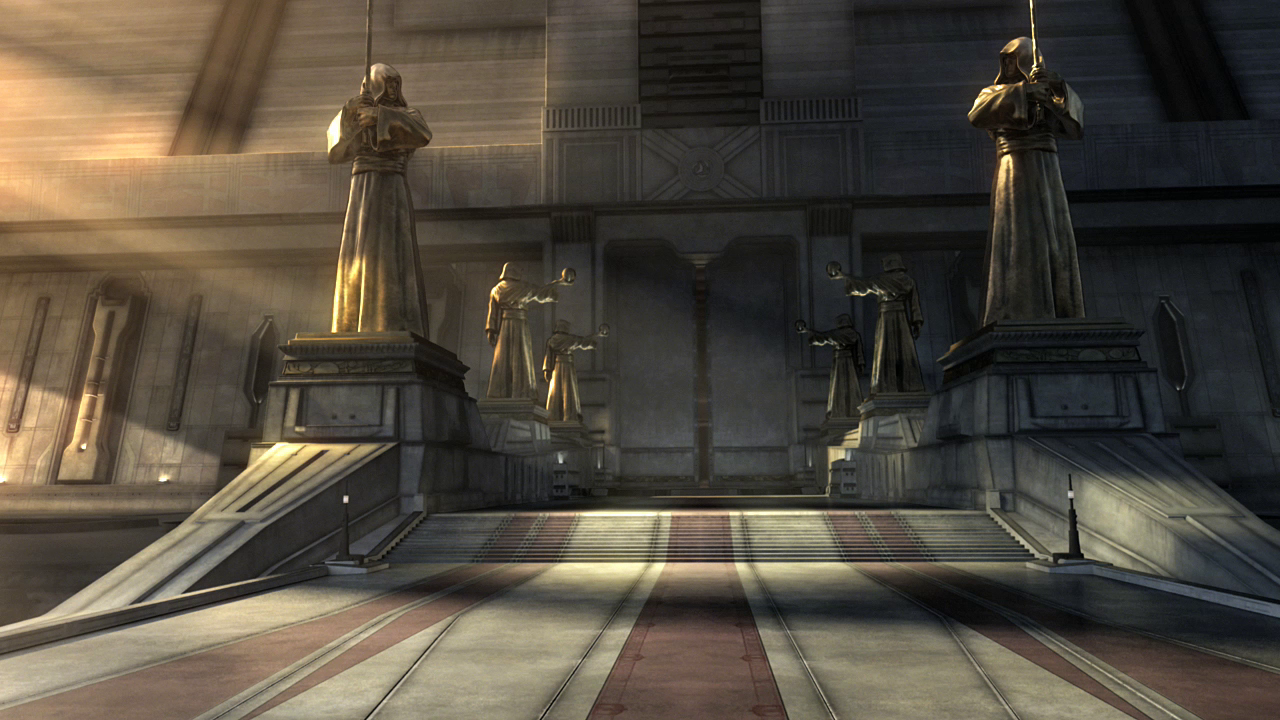
The story of the Coruscant Temple began around 5000 BBY. Following the Battle of Coruscant in the Great Hyperspace War, the Galactic Republic gifted land on Coruscant to the Jedi, specifically the area encompassing the sacred spire, a site containing a powerful Force nexus. This location held spiritual significance for the native Coruscanti. The Republic's intention was for the Jedi to construct a formidable fortress. However, the Jedi preferred to avoid entanglement in the capital's political affairs and resisted becoming a symbol of war, opting instead to build a modest meditative retreat. It was not until the Old Sith Wars, which included the destruction of Ossus and the Great Jedi Library located there, that the Jedi decided to re-establish their academy at the sacred spire. Under the direction of the Order's most insightful members, the Four Masters embarked on the meticulous construction of the Temple Ziggurat. Over the subsequent millennium, the Temple gradually expanded, incorporating various historical artifacts and architectural elements from their past, including tiles and stained-glass mosaics originating from the lost complex on Ossus.
After the construction of the four Jedi Council towers, the Jedi High Council relocated permanently from their temporary meeting location to the High Council Chamber situated atop the northwestern tower. As the Jedi Order became increasingly intertwined with the Republic they defended, they opted to close some of their outlying facilities. They then initiated the transfer of all artifacts from Exis Station to the Temple's Archives. In the wake of the failed Jedi Conclave on Katarr, the Temple was deserted. The remaining Jedi Knights went into hiding as Darth Nihilus and Darth Sion initiated the First Jedi Purge. However, this abandonment was short-lived. The Jedi reorganized and returned to the Temple following the defeat of the Sith Lords.
For the following three centuries, the Temple served as a symbol of the Jedi's influence in the galaxy, assisting the struggling Republic during the difficult Great Galactic War. At the height of this conflict, a dormant Sith Empire resurfaced in the known galaxy and launched an attack on the Temple during the Sacking of Coruscant in 3653 BBY. A Sith raiding party, led by Darth Malgus, advanced to the Temple gates, entered, and eliminated the complex's primary defense force to disable Galactic City's security network. Once the network was compromised, Malgus's team planted explosives within the Temple, detonating them as the Sith fleet bombarded the structure from above. The Temple's exterior crumbled, with the four prominent towers collapsing onto the tiled roof, leaving behind a shell of its former glory. Nevertheless, much of the interior remained intact, symbolizing the Order's condition after the attack.
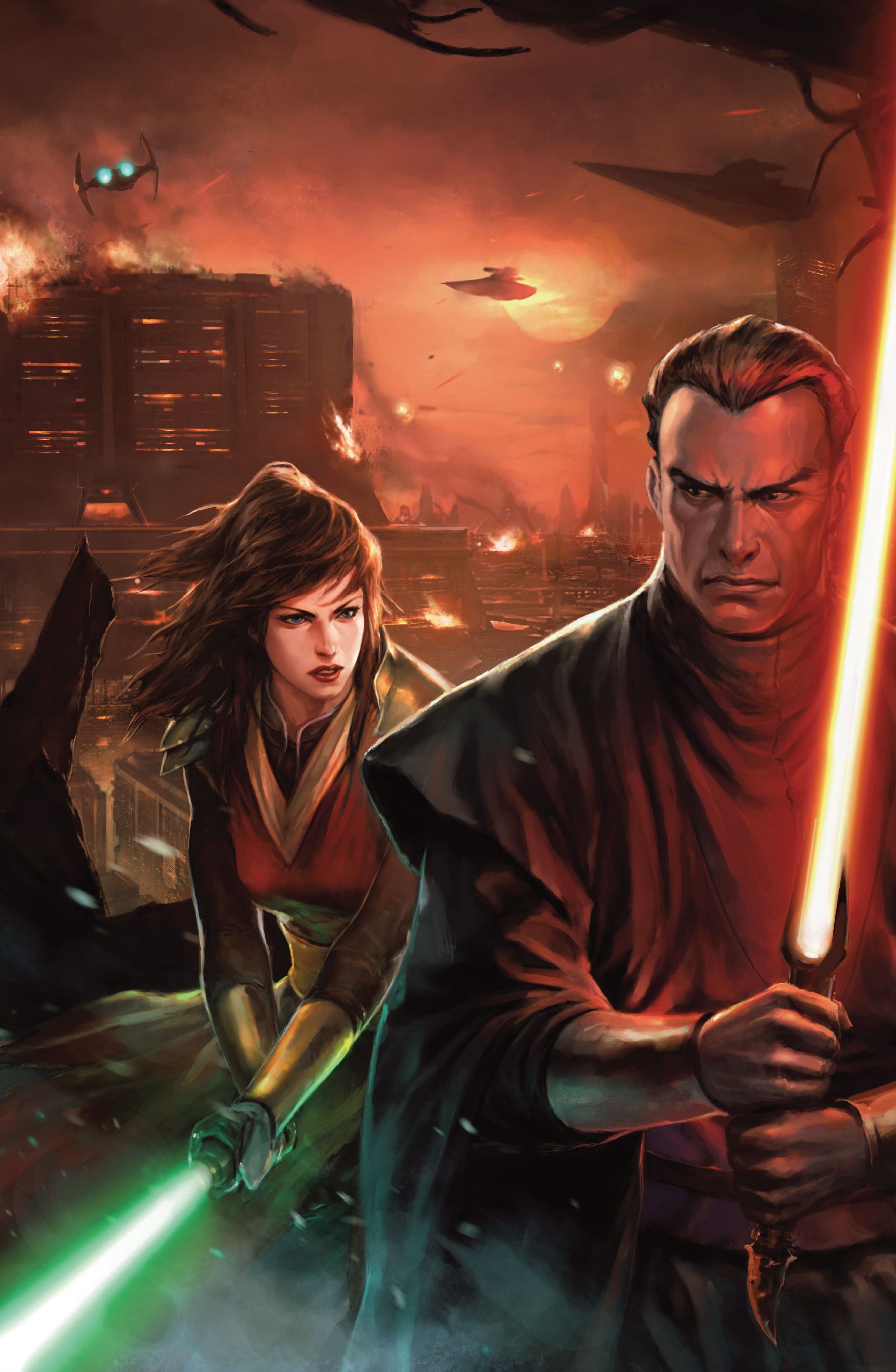
Following the signing of the Treaty of Coruscant, the Galactic Senate voted to postpone the Temple's reconstruction indefinitely due to financial constraints. Interim Supreme Chancellor Paran Am-Ris communicated the decision to Grand Master Zym, who received assurances that the Temple would eventually be rebuilt and the Sith defeated. Shortly after, Grand Master Zym received an anonymous summons to the Temple ruins, promising vital information. Upon arriving, he found Commander [Gin Lesl](/article/gin_lesl] amidst the debris, assuming she had a message for him. However, she was equally confused as the Kel Dor Jedi. At that moment, the bounty hunter Braden revealed that he possessed information concerning the Sith attack on the Envoy and the subsequent death of Master Dar'Nala. Commander Lesl expressed confusion as to why she had been summoned before Braden shot her for having him arrested on Dantooine. Drawing his lightsaber, Zym demanded Braden's arrest. Braden refused and attacked, killing the Jedi Grand Master and leaving both bodies among the ruins.
After the Sith Empire's defeat, the Jedi Order rebuilt the Temple. Over the next three millennia, it expanded significantly, with major additions beginning around 3500 BBY, including the completion of the Jedi Archives circa 2519 BBY, another expansion in 2000 BBY, and the reconstruction of the Temple Spires in 1019 BBY. It was only following the defeat of the Brotherhood of Darkness during the New Sith Wars and the end of the Republic Dark Age that the Temple's reconstruction concluded, marked by the Order's refocusing during the Ruusan Reformation. Consolidating the majority of their efforts on Coruscant, the Jedi closed most of their outlying facilities, disbanded the Army of Light, and began to move away from the militaristic doctrines that had persisted since the war with the Sith. With the Sith believed to be extinct, the Jedi and the Republic entered an era of peace and prosperity known as the Golden Age. Unbeknownst to the Jedi, one of the last Sith had infiltrated the Temple following the Reformation. Darth Zannah, apprentice to Darth Bane, searched the Archives disguised as Padawan Nalia Adollu in an attempt to find a cure for the orbalisks that were afflicting her master. Discovering the Sith threat too late, a task force was dispatched to confront the Sith on Tython. The mission failed but was mistakenly declared a success, allowing the Sith to evade Jedi detection for the next millennium.
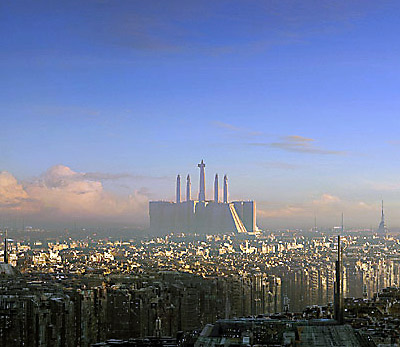
After almost a thousand years of tranquility, a new darkness loomed over the Jedi Order. The future became even more unclear than usual, and the High Council found itself unable to foresee events or sense disturbances as effectively as before. It was during this period of uncertainty within the Order that the Temple became vulnerable to attack.
The Temple first came under threat in 44 BBY when a series of robberies plagued the complex. The High Council tasked Masters Qui-Gon Jinn and Tahl with identifying the thief and bringing them before the Council for judgment. The stolen items ranged from torn tunics to missing training lightsabers, but the threat escalated when the Healing Crystals of Fire disappeared. In an even more alarming incident, an attempt was made on Grand Master Yoda's life while he was in the Room of a Thousand Fountains. Although Yoda escaped unharmed, fear gripped the entire Temple as its walls no longer provided adequate protection against attack. When it was discovered that apprentice Bruck Chun was collaborating with the mysterious intruder, the Dark Jedi Xanatos, Masters Jinn and Tahl began to investigate Xanatos's true motives. Gathering information from Master Yoda, the two Jedi investigators deduced that the Dark Jedi was after the vertex stored in the Temple Treasury. While Tech Specialist Miro Daroon began cycling the sabotage Temple power grid, Jinn and his Padawan planned a trap to lure Xanatos and Chun to the top of the High Council Tower. Jinn managed to protect the Temple and recover the Healing Crystals, but Xanatos escaped to continue plaguing the Order. Chun was defeated by Obi-Wan Kenobi and accidentally killed, falling off a waterfall in the Room of a Thousand Fountains. The Temple was also known as the Palace of the Jedi.
Eleven years after Xanatos's invasion, as the Force became increasingly clouded, The High Council dispatched six of its members, along with several other Jedi, to quell the Yinchorri Uprising. Exploiting the absence of High Council members, the enigmatic Dark Lord of the Sith Darth Sidious orchestrated an attack on the Temple. Employing a terror group of Yinchorri, they silently landed on the Temple Ziggurat and gained entry through the Atrium off the High Council Tower. Inside, the invaders found the accommodation sector deserted and were eventually confronted by a group of Jedi led by Grand Master Yoda. The Jedi successfully defeated the attacking Yinchorri, suffering only the deaths of Jude Rozess and Tieren Nie-Tan.
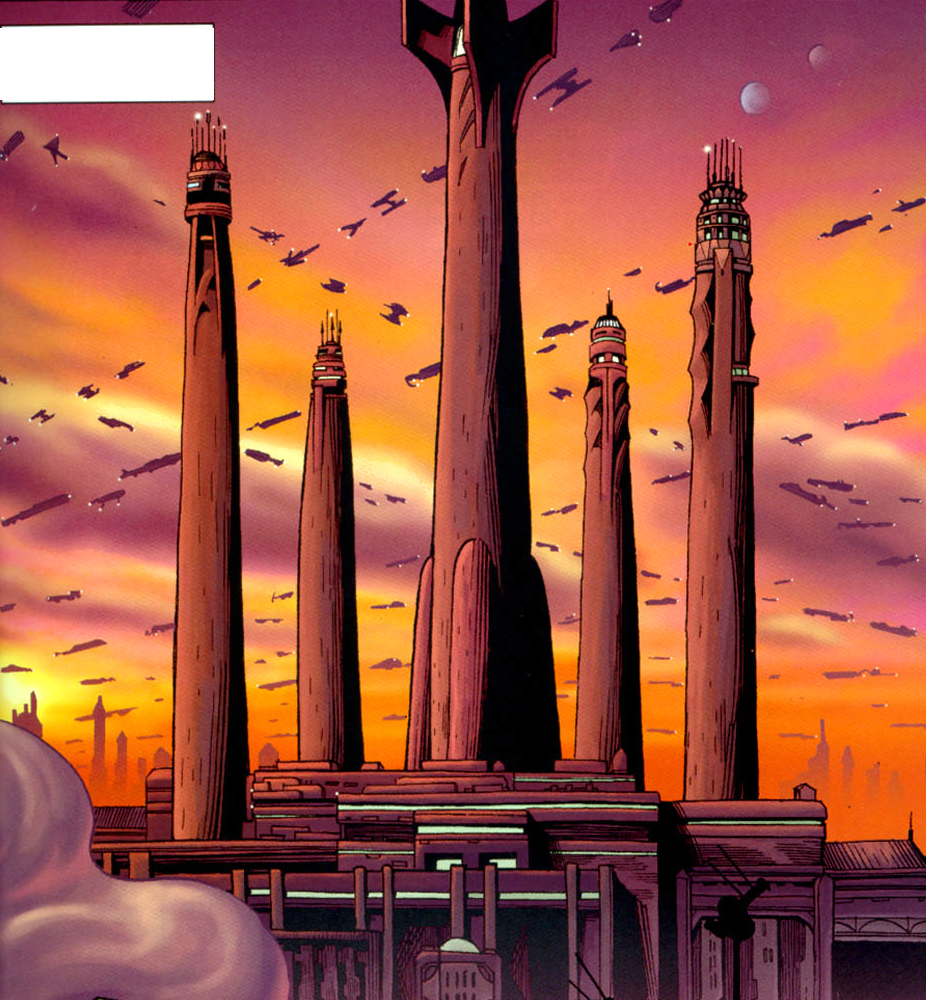
When the High Council became aware of a Sith resurgence following the Invasion of Naboo and the appearance and subsequent death of Darth Maul, they began preparations for an inevitable confrontation. During the Separatist Crisis, new hangar facilities were added to the Council Towers to accommodate the Order's new Delta-7 Aethersprite-class light interceptor, drawing criticism from the People's Inquest group. The group demanded that the Council release its financial records, and they gained further momentum during the "Baby Ludi" custody case when an Ord Thoden woman accused the Order of kidnapping her daughter, Ludi Billane. The Inquest movement established a camp outside the Temple's main entrance, and tensions escalated when a group of University of Coruscant students breached the Second Atrium of the public entrance in the early morning. As two Padawans attempted to pacify the rioting students, who were throwing graffiti bombs across the Atrium, Masters Plo Koon and Ki-Adi-Mundi quickly subdued the marchers using a Jedi mind trick. The students were then arrested and handed over to Judicial officers. When the High Council decided to transport the child to the Kamparas Training Facility, the protesters who had been camping outside the complex for months began a rally led by Firris Palbert. The group attempted to provoke the Jedi by shouting into loudhailers, but they were only met by Judicial Cerisa Vosengoor, who dismissed the claims of Jedi tyranny.
As the Clone Wars erupted across the galaxy, the Temple became a major military planning center, with the Jedi assuming the role of General within the Grand Army of the Republic. Jedi Command now reviewed and evaluated all battle plans and major military campaigns, and the High Council maintained near-constant communication with the Office of the Supreme Chancellor. Chancellor Palpatine and several Senators made frequent visits to the Temple during the war, an occurrence that was uncommon before the conflict. The Temple began to show signs of disrepair as time previously dedicated to maintaining the marble floors and cleaning the exterior's bronzium gutters was redirected to more pressing tasks, such as maintaining the Jedi Order's spacecraft.
Darth Sidious continued to create problems for the Temple throughout the war. Ten months into the conflict, Count Dooku, Head of State of the Confederacy of Independent Systems, led his Droid Army and the Dark Acolyte Trenox into the Temple on a mission to destroy the invaluable Temple Archives. Jedi Knight Anakin Skywalker was present at the Temple when the Sith-led army entered the Archives and managed to kill Acolyte Trenox and defeat the C-B3 cortosis battle droids that sought to destroy the Stacks. While Skywalker dealt with the droids, Dooku stole a precious holocron from the repository of knowledge and escaped the Temple unscathed. The Temple Library was subsequently attacked by Sith-employed bounty hunters Cad Bane and Cato Parasitti. Using schematics provided by Sidious, Bane bypassed the exterior defenses and navigated the ventilation system with the assistance of Parasitti, who was stationed in the Library disguised as Master Ord Enisence. While Parasitti was captured by Padawan Ahsoka Tano, Bane distracted the other Jedi long enough to break into the Holocron Vault and escape the planet.
Sometime in 20 BBY one of the Jedi Temple's hangars was bombed. An investigation led by Anakin Skywalker and his Padawan Ahsoka Tano resulted in the arrest of Letta Turmond, who had planted nano-droids in her husband, a Temple worker, causing the hangar's destruction.
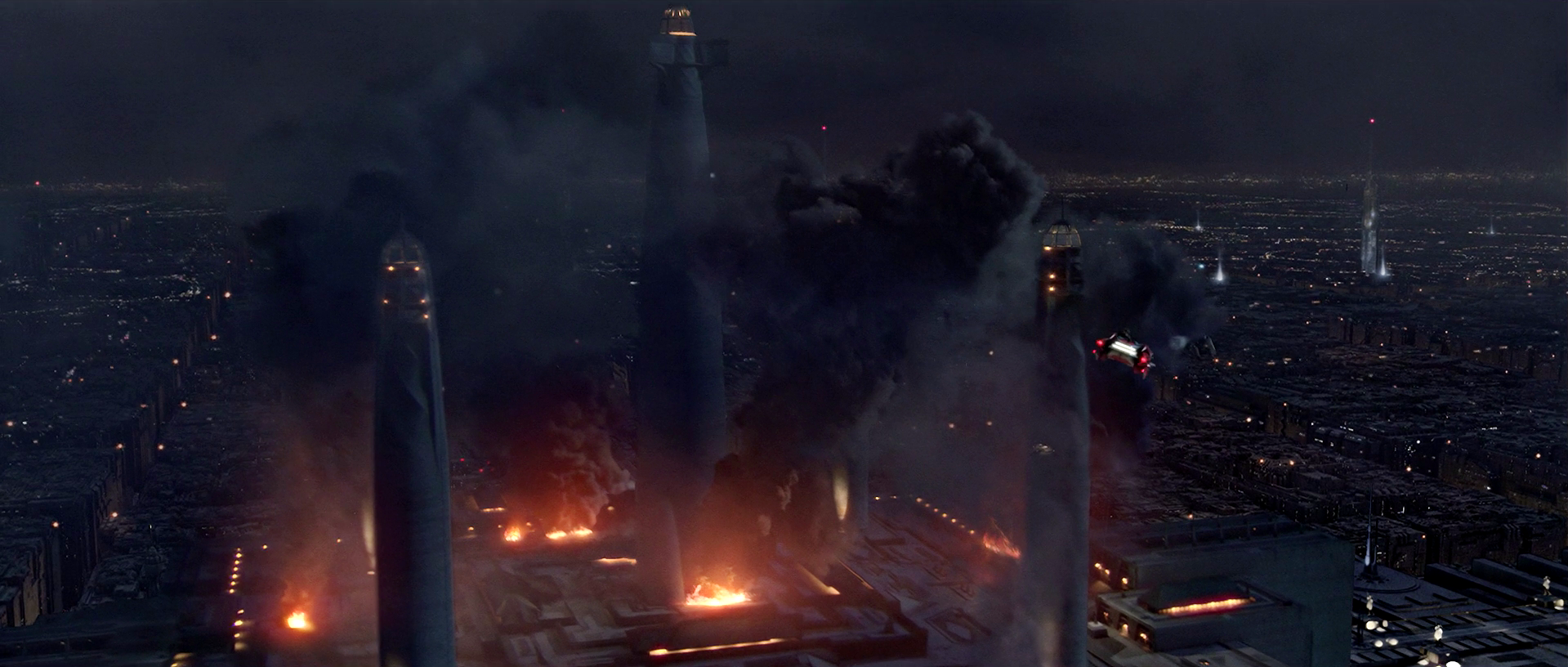
In 19 BBY, following the Battle of Coruscant and the work of Judicial Captain Dyne, the High Council became suspicious of the Office of the Supreme Chancellor and suspected Darth Sidious of influencing the Chancellor. Knight Anakin Skywalker eventually discovered, after the defeat of General Grievous on Utapau, that Chancellor Palpatine and Darth Sidious were the same person. Masters Mace Windu, Agen Kolar, Kit Fisto, and Saesee Tiin departed the Temple to confront the Sith, leaving Master Shaak Ti and Gate Master Jurokk in charge of the Temple's defense. They turned off all nav beacons and signal lights, armed the older Padawans, and sealed all blast doors in preparation for a Sith attack. However, the duel with the Sith took a disastrous turn when Jedi Knight Skywalker betrayed his masters and assisted Sidious in the murder of Master Windu. Sidious ordered Skywalker, now Darth Vader, Dark Lord of the Sith, to raid the Temple with the assistance of the 501st Legion. Vader marched on the Temple steps, slaying the unsuspecting Gate Master Jurokk and initiating the brutal slaughter of every Jedi present. While many Jedi were dying across the galaxy as part of Order 66, many of the Order's most promising members perished at the Temple. Vader stormed the Archives and killed Chief Librarian Jocasta Nu when she refused him access to the Temple beacon. Jedi Battlemaster Cin Drallig led a final stand of younglings and Padawans in the Fountain Room but was unable to protect his charges from the overwhelming number of blaster bolts. Furthermore, Three Jedi Masters attempted to retake the Archives from the 501st, but were all defeated.
Although many Jedi and Temple employees died within the Temple that night, Jedi Master Shaak Ti led a group of Padawans and their masters in a retreat. Master Kazdan Paratus was another Jedi who successfully escaped the Temple, fleeing to Raxus Prime to live in madness, having failed to save the Temple. After securing the building, Vader reported to his new master before being dispatched to Mustafar to slaughter the Separatist Council stationed there.
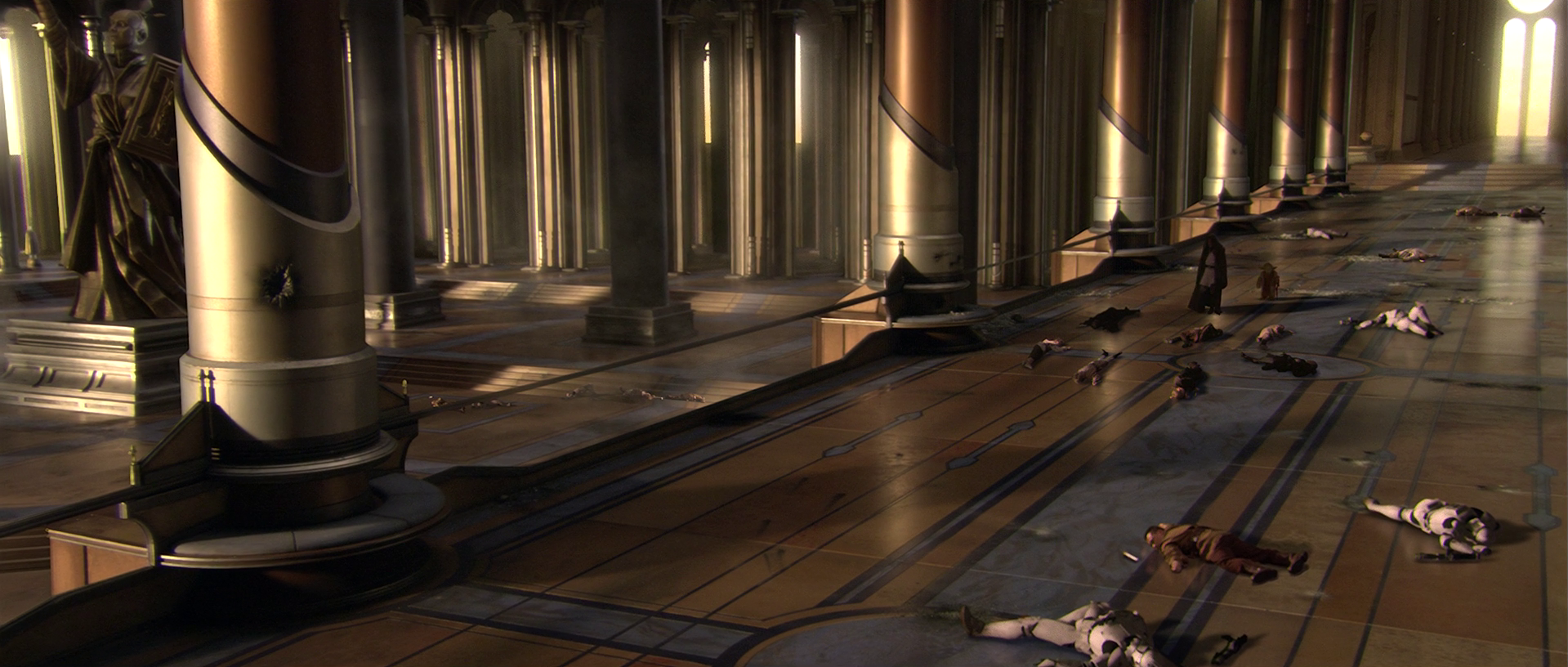
Following the Declaration of a New Order and the establishment of the Galactic Empire, the Sith used the Temple as a trap. They broadcast a false signal to surviving Jedi, falsely claiming that the Clone Wars had ended and urging them to return to the Temple. The Empire planned to execute the survivors of Order 66 as they returned home. Clone assassins, specifically trained to kill Jedi, guarded the Temple beacon, while clones disguised as Jedi patrolled the exterior to deceive any returning Jedi. Fortunately for the remaining Jedi, Grand Master Yoda and Master Obi-Wan Kenobi had been rescued by Senator Bail Organa and decided to return to the Temple to deactivate the beacon. Entering through a sublevel hangar, the Jedi killed Decoy Squad Five and proceeded through the Temple until they reached the central security station, where they defeated the clone assassins and recalibrated the beacon to warn the survivors to flee and hide. While there, Kenobi accessed the security holos and confirmed his worst fear: Anakin Skywalker, his former student and friend, was responsible for the slaughter. The two Jedi separated to hunt down the two Sith and kill them; neither succeeded, but Vader was critically injured, hindering Sidious's plans for him.
After cross-referencing the names of the dead with the Archives roster, the clone troopers dragged the bodies of the fallen Jedi onto the public steps and arranged them on a makeshift pyre for all to see. In the days following the Temple's occupation, a group of Jedi gathered among the crowd outside the public entrance, but only one stepped forward. This lone Jedi attacked the troopers stationed on the steps, imploring his fellow Jedi to join him, only to be cut down by a barrage of blaster fire.
Vader was later sent back to the Temple by his master to retrieve the Sith holocrons stored there. Vader recognized this as a test of his resolve; if he could navigate the Force-imbued Temple without succumbing to the horrors that had occurred there, he would be commended. Vader was accompanied by Head of Imperial Intelligence Armand Isard, whose men had detected a hacker in the Archives. Vader suspected that the hackers were Purge fugitives Roan Shryne and Olee Starstone. While Isard obtained a location for the two Jedi, Vader was unable to reach them before they escaped again. The Imperials failed to detect Padawan Ekria, who managed to infiltrate the database and erase all records of herself and fellow Padawans Drake Lo'gaan and Zonder.
Jedi and Sith were not the only ones who visited the Temple after its abandonment. Captain Gregar Typho, the former bodyguard of the deceased Senator Padmé Amidala, broke into the Temple in an attempt to uncover the cause of her death. While searching the Temple Library, Typho encountered the bounty hunter Aurra Sing, who was looking for information on the whereabouts of the Jedi Jax Pavan. In the ensuing duel, Sing was knocked unconscious, and Typho escaped unharmed, remaining unaware of the circumstances surrounding Amidala's death.
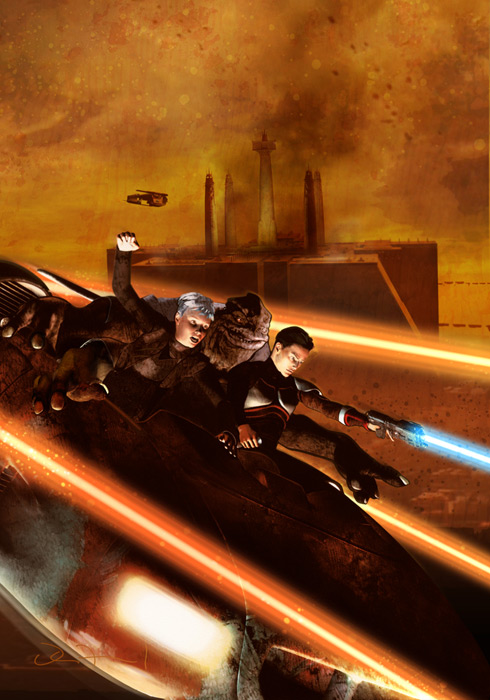
After the Dark Side Adepts had essentially removed all items of significance from the Temple, the Empire kept a small contingent there to provide security against potential Jedi incursions. Grand Inquisitor Malorum established his headquarters within the Temple, using the former living quarters of the Grand Master as his base of operations. While Malorum was in discussions with Darth Vader on the main floors of the Temple, the former Jedi Ferus Olin and his associate Trever Flume secretly entered his office. They began a search for information pertaining to Polis Massa under the orders of Master Obi-Wan Kenobi, who had initiated the assignment. Eventually, Malorum and Vader returned to the office, leaving Olin and Flume with no alternative but to jump out of the window. They successfully escaped into the depths of Coruscant's Underworld. Soon after, Olin, accompanied by Master Fy-Tor-Ana and Flume, went back to the Temple. Using Master Ana's knowledge of the modifications made to the Temple during the Clone Wars, the trio managed to infiltrate the Storage Level through a maintenance hatch. Instead of a Jedi prison, they discovered a large storage area filled with the lightsabers of fallen Jedi, along with a motion sensor that would alert stormtroopers to their location. As they fled the Temple, the group found that the complex was set to self-destruct via a device placed in the Temple's core by Inquisitor Malorum. Determined to prevent the Temple's complete destruction, the Jedi and Flume rushed to the reactor core. Using Flume's expertise with explosives, they successfully disarmed the weapon. Although their mission appeared successful, Olin was apprehended by stormtroopers before he could join Ana and Flume in their escape.
Several months later, Olin escaped from Sith custody, but he struggled with the influence of a Sith holocron given to him by Darth Sidious. He returned to the Temple to uncover the truth about the supposed resistance leader Flame, only to discover that she was secretly working for the Empire. Olin attempted to warn the Resistance members meeting with the traitor, but he was unable to prevent their massacre. Before fleeing the Temple, Olin was confronted by Darth Vader. The confrontation with Vader led Olin to the Chambers of the High Council, where he was ultimately struck down in the High Council tower atrium. Vader, presuming Olin was dead, left his body to decay; however, Olin was still alive and made his final escape from the Temple.
The Temple's activity gradually decreased to a small garrison of troopers tasked with preventing intruders. After it was completely secured, Emperor Palpatine ordered modifications to certain areas to reinforce the idea that the Jedi were a cruel and malevolent threat. Archived data was altered to portray Jedi Masters as corrupt as the Separatist leaders, and Sith statues were added to further discredit the Jedi Order. This propaganda was prepared in anticipation of Palpatine's guided tours of the Temple, an exclusive privilege reserved for the Empire's highest-ranking members and elite individuals. Shadow Troopers guarded the Temple's treasures at every entrance under the command of Imperial Senate Sentinels.
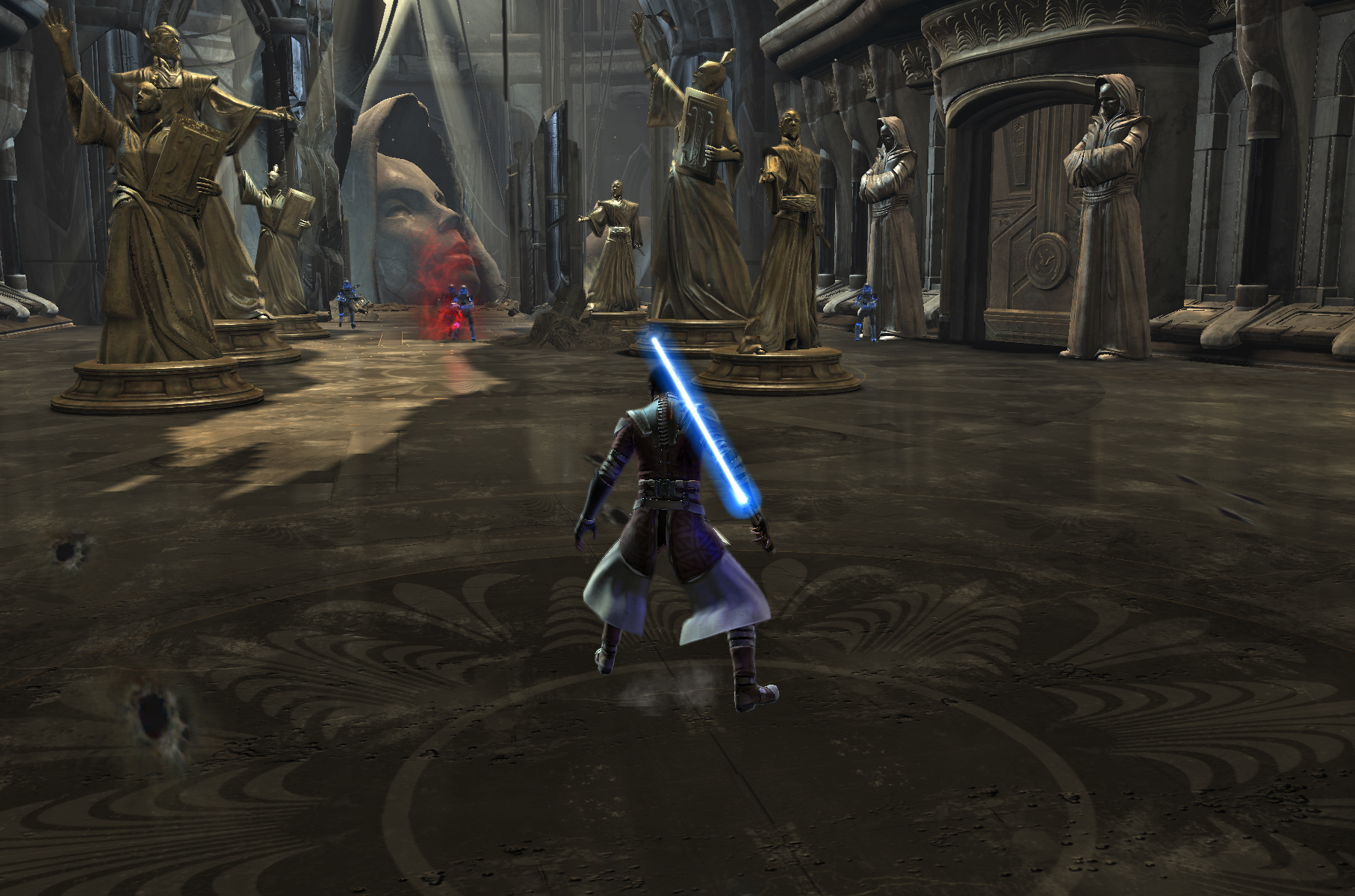
In the year 2 BBY, after years of undisturbed desolation, Darth Vader dispatched his secret apprentice, Starkiller, to the Temple to undergo the Jedi Trials. During Starkiller's initial mission, he overcame the troopers guarding the Temple steps and faced a simulacrum of the Sith Lord Darth Desolous within the Jedi Trials Chamber. Starkiller emerged victorious from the battle against the illusion and departed the Temple before reinforcements could arrive. Shortly afterward, Starkiller returned and infiltrated the Archives to complete the Trial of Insight before pursuing the elusive Jedi Master Shaak Ti. Inside the Archives, Starkiller engaged in combat with a simulacrum of Darth Phobos and overcame her illusionary tactics before defeating her. Several months passed before Starkiller returned to complete his Trials, this time acting independently, not under Vader's orders. During this mission in the Temple, Starkiller entered the Tower of First Knowledge and defeated the troopers stationed there. Upon entering the Holocron Chamber, the Gatekeeper of a large holocron instructed Starkiller to explore the depths of the Temple and complete the Trial of the Spirit. Within the ruins of the Temple's basement, the assassin defeated a mirror image of himself and left the Temple for the third and final time.
The Temple, a symbol of the consequences of defying the Empire, remained standing even after the destruction of the second Death Star, 23 years after its initial abandonment. It wasn't until the New Republic drove the Empire from Coruscant that the Temple was revisited. With the Republic in control of the capital, Luke Skywalker traveled to the ancient structure to learn about his lost heritage. After deciding to revive the Order, Skywalker invited one of his students, Tionne, to restore the Archives and add information from the Galactic Civil War. Eventually, the Temple's five towers collapsed during the Lusankya catastrophe and were removed, replaced by a new enclave that served as both a diplomatic hub and a training ground for new Jedi, separate from the Jedi Praxeum on Yavin 4. It was here that Skywalker and Master Mara Jade held their wedding ceremony. The facility remained in use until the Order was forced to retreat into hiding when the Yuuzhan Vong invaded the galaxy and captured Coruscant.
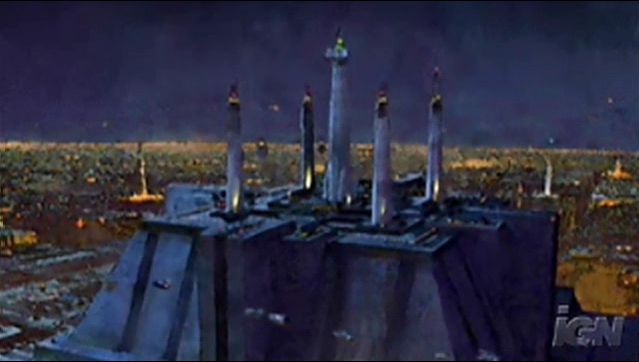
During the war, Masters Skywalker and Knight Tahiri Veila journeyed to a "Vong-formed" Coruscant after receiving a dark premonition. While traveling across the planet's surface, the Jedi were led to the Temple's ruins by a disturbed individual known as Lord Nyax to the Coruscanti he had enslaved. Among the ruins, the Jedi found Nyax's slaves working to destroy the old structures surrounding the Force-nexus at the heart of the sacred spire. Determined to prevent a Force-related catastrophe, the Jedi engaged Nyax in a fierce battle that resulted in further destruction of the once-great complex. Fueled by the sacred spire's unlimited energy, all four combatants were evenly matched. Eventually, Veila managed to injure Nyax by diminishing her presence in the Force long enough to approach the Dark Jedi. Using razor bugs to do her work, Veila pierced Nyax's armor deeply enough to cause him to lose the battle. Before he could recover, two Yorik-et fighters opened fire on him, destroying him. Before his death, Nyax imbued his hate and despair into the sacred spire, tainting the Force energies emanating from its peak.
Within weeks of Nyax's death, the imprisoned Jedi Jacen Solo was pursued to the Temple ruins by Yuuzhan Vong warriors. Managing to enter a still-standing area, he sensed the dark energies present. He was rescued from certain death by his adopted teacher, the enigmatic Vergere. Leading Solo through the ruins, Vergere brought him to a dimly lit room. Glow globes hanging from the vaulted ceiling revealed dozens of Yuuzhan Vong warriors. Solo drew upon the Force energies, which were saturated with the dark side, to destroy the hall, collapsing the ceiling and crushing the Yuuzhan Vong warriors. Injured and broken, Vergere questioned Jacen why the Jedi, who advocated for peace, would knowingly construct their Temple on a dark side nexus. Withholding information about the Nyax fight and ignoring the events of Order 66, Vergere manipulated Solo by claiming that there was no light or dark side, and therefore the nexus held no allegiances.

Following the Yuuzhan Vong War, Cal Omas, the Chief of State of the Galactic Alliance, ordered the construction of a new Temple for the Order. Using blueprints recovered from the ruined Archives, the Reconstruction Authority rebuilt the new Temple almost identically to its previous state. However, there were some differences. A new pyramid made of transparisteel and duracrete was built over the exterior, encasing the Council spires within. Many members of the reformed High Council worried that the commitment to preserving the past indicated that the Jedi were unable to move forward and would once again become tools of the government, rather than a dignified tribute to their ancient Order.
After standing guard over Coruscant for nearly a century, the Temple was seized in 130 ABY and renamed the Temple of the Sith after Darth Krayt and his new Sith Order took control of the Galactic Empire. Krayt removed the transparisteel pyramids and redesigned the Temple to instill fear and enforce obedience. Smoke constantly billowed from the central stone pyramid, filling the Precinct with a gloomy smog.
It was subsequently reclaimed by the Galactic Alliance and the New Jedi Order in 138 ABY and restored to its original design.
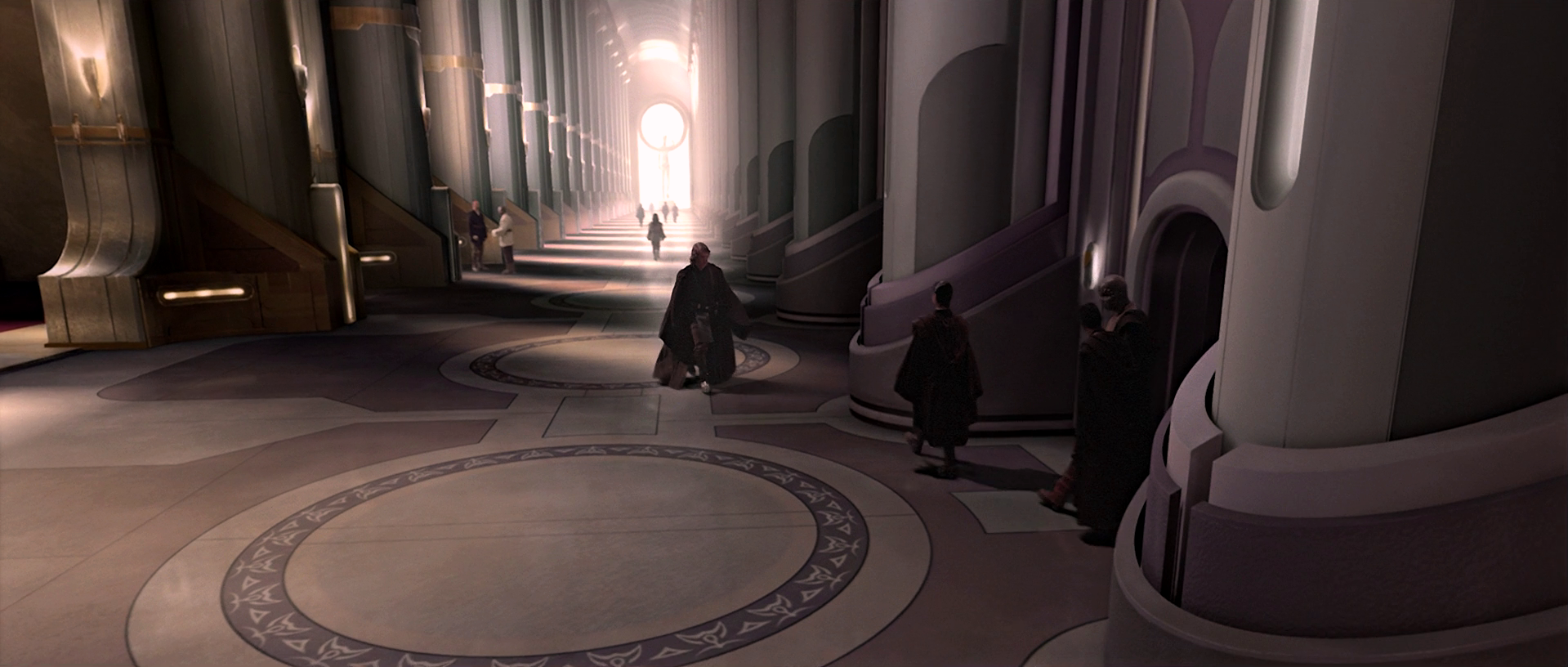
The Jedi Temple, a colossal structure that rose over a kilometer above the surrounding buildings, appeared as a fortress but served as a place for meditation and quiet contemplation. Strategically situated in a secluded area of Coruscant near the Senate District, the Temple occupied a large city block in the Temple Precinct. The upper reaches of the Sacred spire, a towering mountain that extended from the planet's crust far below, were concealed within the heart of the Temple ziggurat. The mountain's uppermost peak emerged from the top of the Temple's base, forming the foundation of its central tower, Tranquility Spire. Surrounding the tallest tower's finned peak were four shorter towers located on the ordinal-oriented sides of the complex. Each tower contained a simple Council Chamber at its summit, serving as meeting rooms for the four Jedi Councils. The ziggurat shape of the edifice, along with the five spires, symbolized a Jedi's journey to enlightenment through the Force.
The Temple, separated from the surrounding urban sprawl by the expansive Temple Court, which was adorned with bronzium statues of deceased Jedi heroes and scholars, was primarily accessed via the Processional Way. This wide promenade bisected the Court and led to the stairs of the main entrance, crowned by four bronzium statues. The outer statues depicted Warrior Masters with their lightsabers activated, while the inner statues represented two hooded Sage Masters. Beyond these statues, a series of monolithic pylons stood in the entrance courtyard. Arranged four across and three back, the front pylons were decorated with reliefs depicting the Four Masters, Jedi who helped establish the Temple in ancient times. The entrance staircase beyond these pylons led into the Temple's vast main hall, which extended to the formal Great Hall. The main hall's pillars and soaring mezzanines stretched out and around the base of the Temple, connecting with the other three formal entrances and forming the Temple's support structure.
The Temple had three other entrances located on the other cardinal-oriented sides: the northern public entrance, reserved for non-Jedi visitors, included several public annexes. To ensure the Temple's safety and privacy, five Padawans were assigned to guard the Temple during the day, while two Knights oversaw the watch in the evening. The Jedi Gate Master supervised all guard duties throughout the Temple. Following the Temple's destruction during the Yuuzhan Vong War, the Reconstruction Authority recreated the ancient edifice almost perfectly. The stairs were rebuilt without the statues of the Four Masters, and the main hall was equipped with additional security systems. Security droids were stored in pillars along the hall, controlled by Temple Security and programmed to apprehend any intruders.
Construction on the Temple proceeded outward from the central, natural mountain in a circular pattern over the centuries before the structure adopted its ziggurat form. The Temple could be divided into wings or quarters for administrative purposes, but for the Jedi, it was a unified entity used by almost every Jedi from its inception until the Great Jedi Purge. Each quarter was crowned by the tower of the Council that oversaw the specified chambers in that sector of the Temple. The northwestern quarter was overseen by the Council of First Knowledge, which managed the Jedi academy of Coruscant. Every member of the Order attended the Academy, and graduation occurred when an initiate was selected for further training by a Jedi Master. In the southwestern quarter, the High Council maintained its headquarters and housed the offices of the Jedi Service Corps. This area, the diplomatic center of the Order, also housed many training facilities for lightsaber combat and facilities where Jedi could build or repair their lightsabers with the help of a weapons specialist. Because most of the Temple was restricted to members of the Order, the northeastern area under the Council of Reassignment was dedicated to the Public Center. The southeastern quarter contained the Order's administrative headquarters, an area furnished with many gardens and offices used by the Council of Reconciliation.
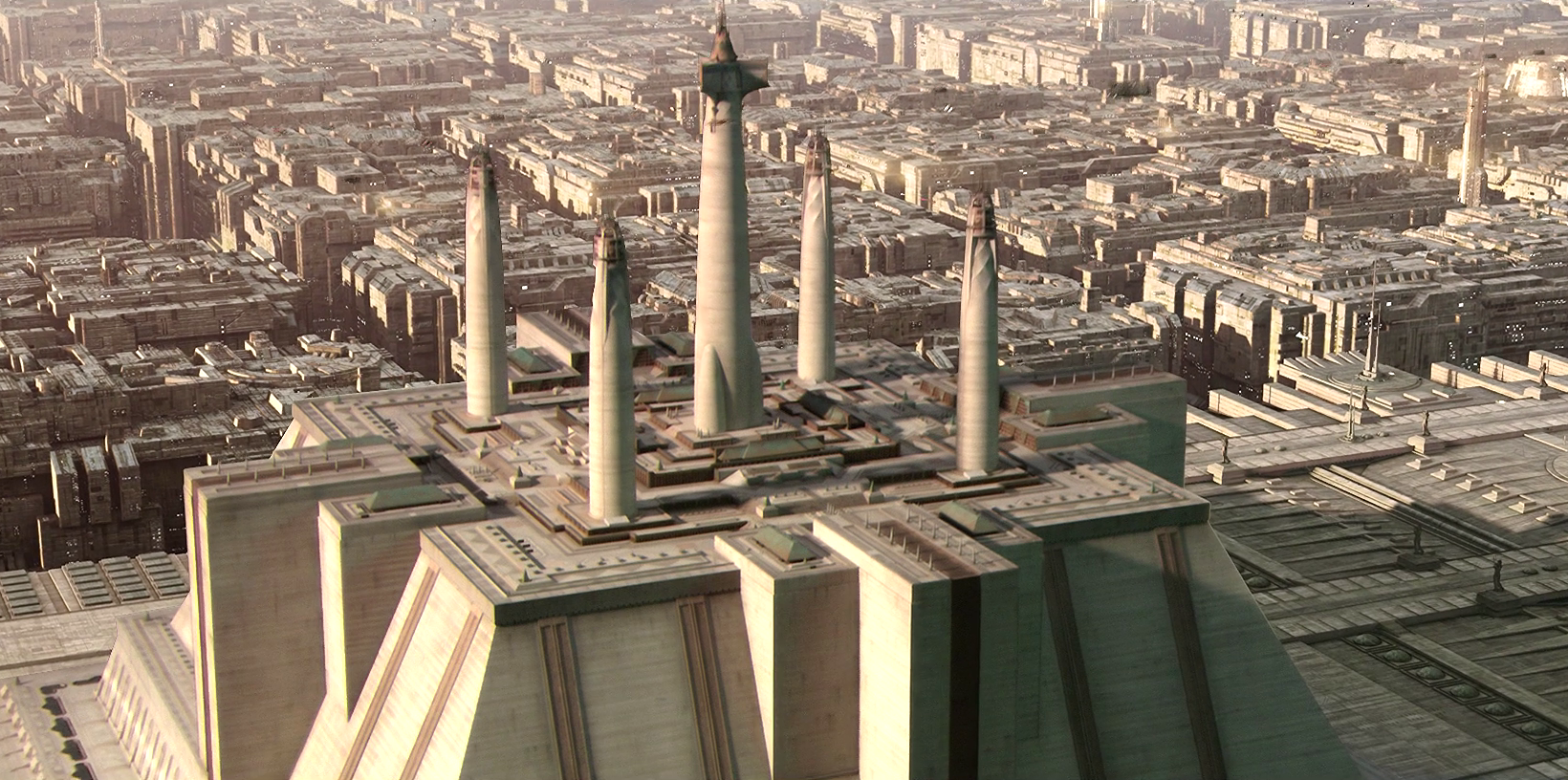
The complex's five towers, fully rebuilt in 1019 BBY as part of the last major expansion, were supported by a high-tensile substance called magnate, which helped support the thin frame of the towers. The central and tallest tower, known as Temple Spire, was built over the last visible peak of the sacred spire and was the tallest structure for kilometers. Traditionally the most important tower, Tranquillity held the most sacred chamber in the complex, containing the ancient texts of the founding Jedi, some of which survived from Ossus. Temple Spire contained the Hall of Knighthood near its summit, meditation chambers farther below, large memorial statues of revered Jedi suspended by repulsorlift pads, and the mountain peak around which the Temple was built. The peak was surrounded by a meditation balcony with a lower balcony presenting holo-depictions of the Order's history. Younglings were brought here by their masters for their first introduction to Jedi knowledge. From this point, the ancient meditation chapels of the sacred spire were accessible via stone bridges, leading deep into the mountain's core. On the northern slope was the Chamber of Conclave, where an annual conclave was held, with outlying Jedi reporting to the High Council on important events or projects.
Crowned with high-gain transmission antennae, the spires enabled the communication center to maintain contact with thousands of distant worlds. Jedi Command was based in the Towers during the Clone Wars, maintaining a Situation Room in each with a constant connection to the HoloNet. The large Operations Planning Center below the Council Chamber was an open-air room with a holomap where hotspots across the galaxy could be analyzed by the Councils. The southwestern spire, known as the High Council Tower, housed the Jedi High Council, the governing body of the entire Order. The northwestern tower held the meeting place of the Council of First Knowledge, the leaders of the Jedi academy on Coruscant. Across from this Spire stood the Reassignment Council Tower, where the Council organized work for young Initiates not chosen by Jedi Masters to become apprentices. To the southeast was the Tower of Reconciliation, whose chambers housed the Council that sought peaceful settlements to political disputes across the Republic.
Near the central spire's base was an ancient gnarled tree with golden boughs, where lightsaber training classes were held during the Clone Wars.
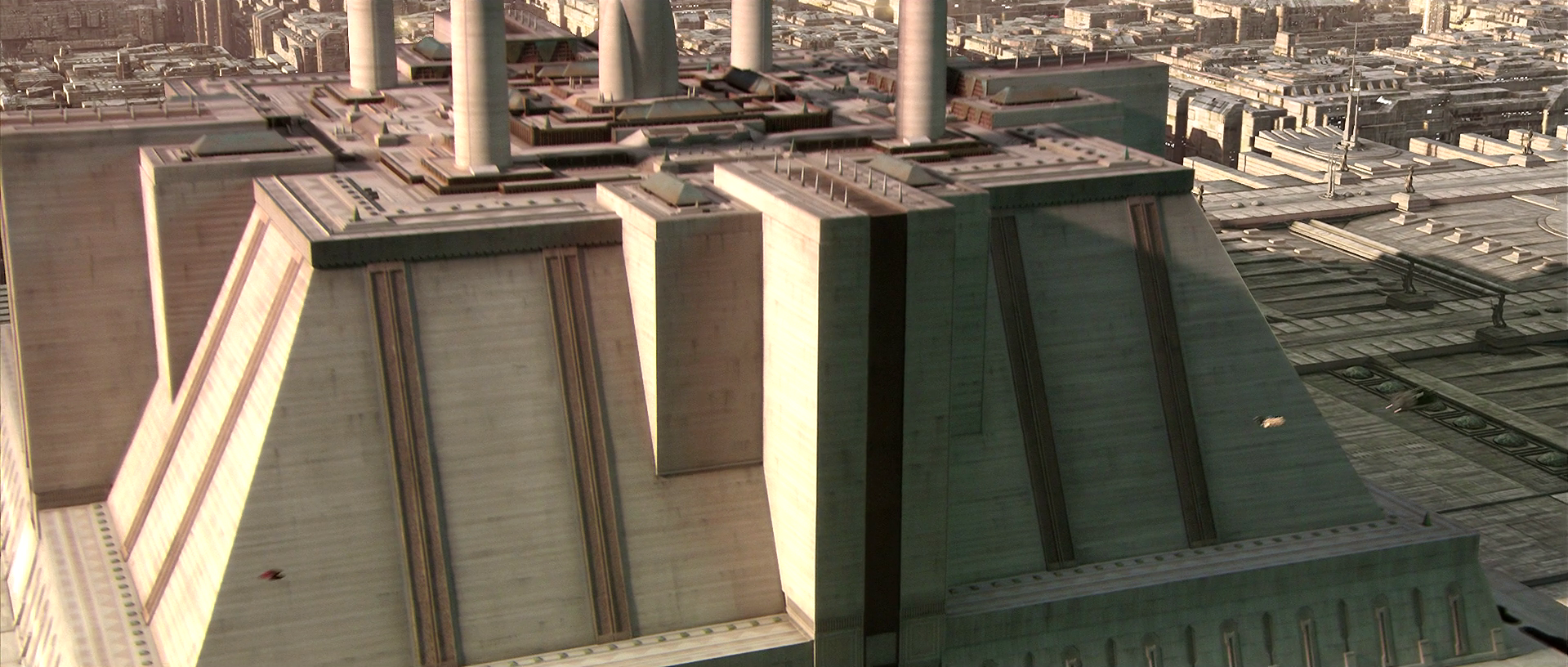
Having expanded outward from the sacred spire in a circular pattern over millennia, the Temple Ziggurat could be dissected into shells to reveal its history. Directly around the sacred spire were the ancient meditation chambers and grand stone structures that formed the original enclave. These temples, chapels, and sanctuaries were among the largest in the Temple, capable of housing hundreds of Jedi. By the Clone Wars, many of these ancient halls had fallen into disuse, becoming dusty relics of a grander era. As the Temple Precinct rose to modern levels and the Temple Court took shape, the Order built outward and upward, erecting towering stone buildings that served as office space and dormitories. Stone towers and obelisks jutting from the mountain and its rocky outcroppings were labyrinthine in design and later abandoned by many of the Temple's occupants. By the Clone Wars, only the eldest Jedi Masters could navigate the ancient designs of the oldest Temple structures and unlock their hidden secrets. The ancient library and study halls were built above the main entrance, a monolithic chamber where bronzium statues lined the main entry mezzanine. As time progressed, the stone structures were covered with a dark durasteel outer layer incorporating red stone, giving the Temple a dark and subdued appearance from the outside. What became the base of the Temple's Ziggurat was made up of columns and supports that held the structure up. The construction of the Room of a Thousand Fountains, with a ceiling reflecting the sky of a terrestrial garden world, and other Meditation Gardens brought a rediscovered sense of nature and harmony to the Temple, not found elsewhere on the city-covered world. The Lake Level and an expansive menagerie beneath the Temple provided additional places of natural beauty and study. The Detention Center was built above the Fountain room to contain Sith Lords and their creatures that ran rampant during the early Republic era. The Temple's architects incorporated recovered materials from Ossus, stored at Exis Station, into the Temple's design. Marble tiles were placed in halls and chambers, and a portion of a recovered stained-glass arcade was placed in the Meditative Walkway running the perimeter of the Temple's base. At each corner, chapels were built to mirror the aspects of the Force reflected in the towers constructed on the Temple rooftop later in its history.
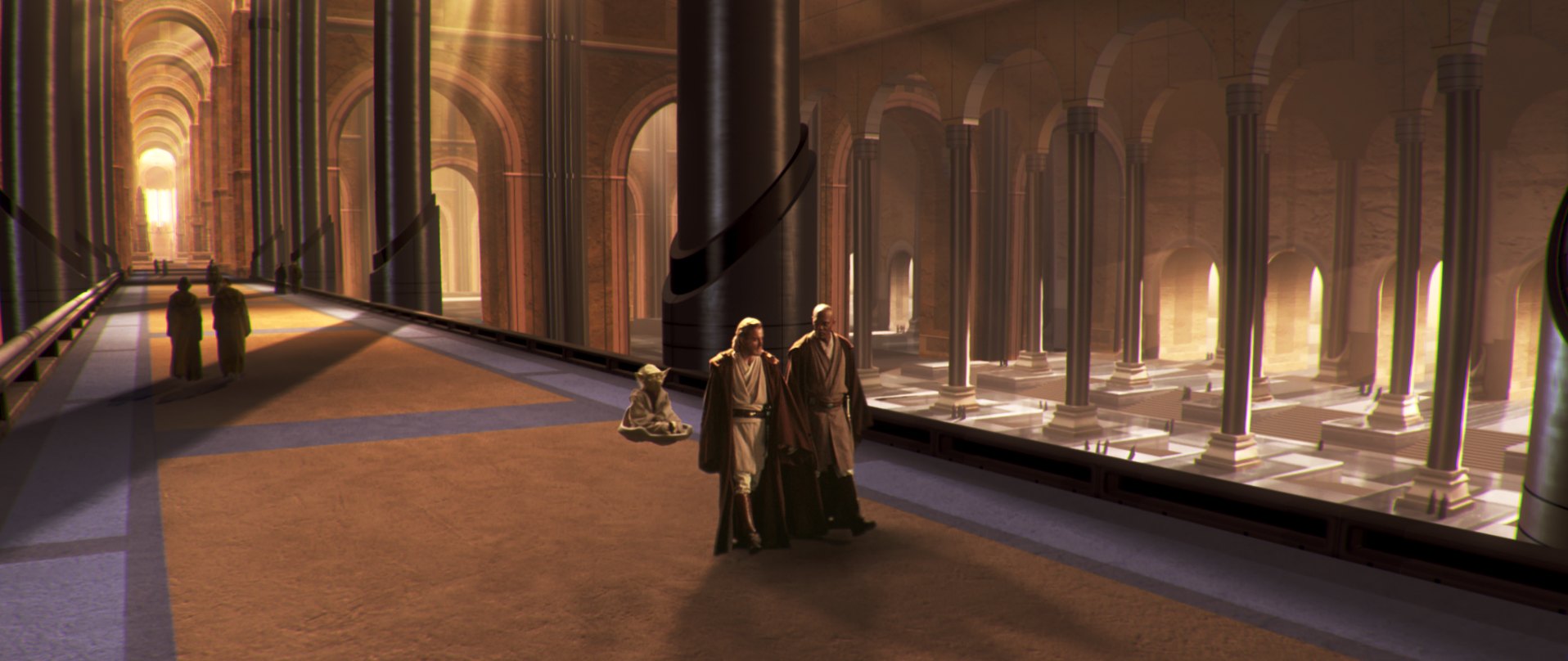
Despite numerous attacks on the Temple during the early years of the Republic, it was continually restored and rebuilt stronger than before. Following the rebuilding in 3500 BBY, decades after the Sacking of Coruscant, the Temple once again housed the Order and its academy, which had previously relocated to the Order's homeworld of Tython. Architectural treasures were repurposed, transforming the old library and study halls into a museum of Temple history and a formal banquet hall after the Jedi Archives were established in 2519 BBY. The Temple's structure continued to expand through 2000 BBY, and the spires were rebuilt in 1019 BBY, marking the end of major expansions. The pale stone exterior finished, the Temple shone as a beacon of hope and a reminder of the Order's strength. Statues, memorials, and gardens covered the roof of the Ziggurat, along with wide-open plazas serving as landing platforms for visiting diplomats. Clerestories were incorporated into the roof to allow natural light to spill into the Temple's halls and gardens, while the rest of the Temple was lit with a soft, soothing blue light. The accommodation sector was designed with adjustable rooms to accommodate the many species of Jedi through specialized atmosphere adaptors.
As part of the Jedi Service Corps' research operations, the Agricultural Corps maintained a laboratory at the Temple. The Medical Corps had a presence in the Halls of Healing, with an express turbolift connecting the Temple to the Republic Central Medcenter. The Healing Halls were where Jedi healers practiced the Order's most sacred techniques, saving countless Jedi lives over the years.
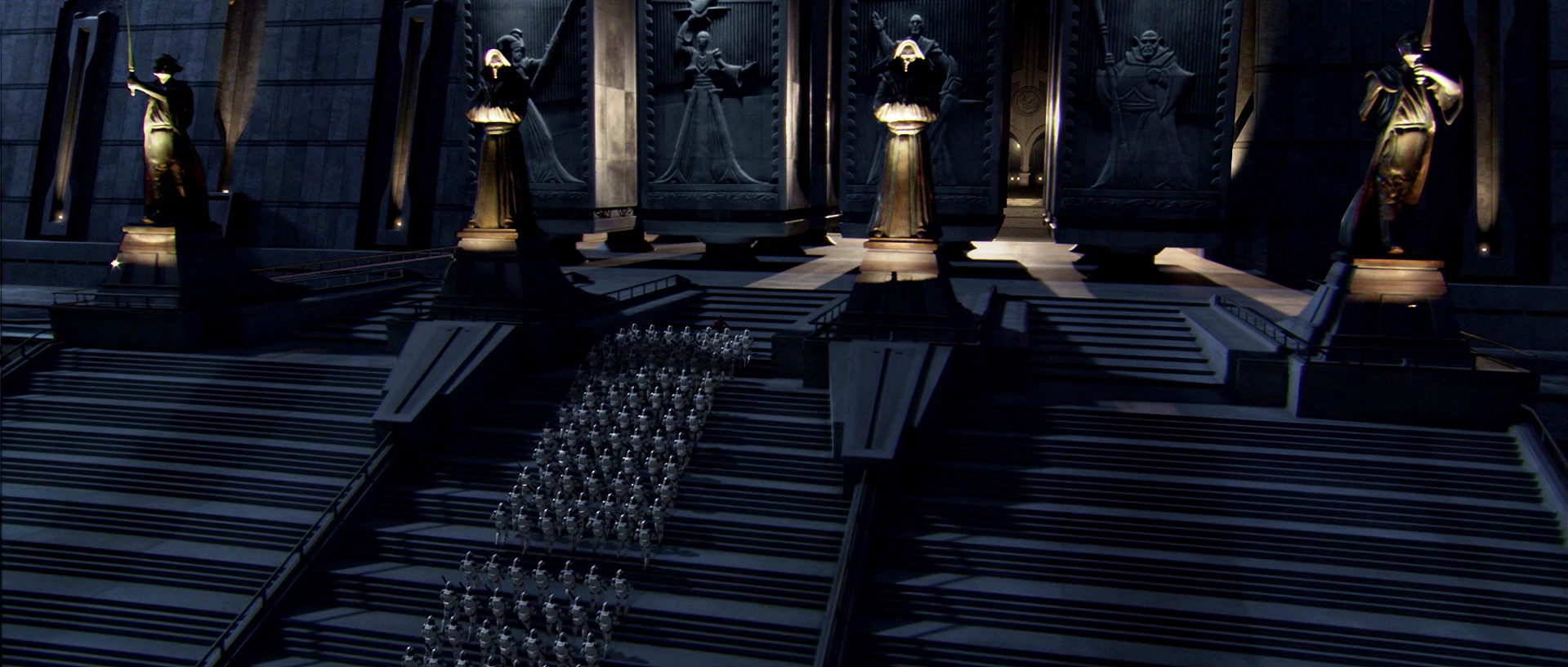
Leading up to the Clone Wars, observations indicated the Temple's deterioration, especially its facade. Paint was peeling off the middle and lower sections, and extensive green streaks from bronzium gutters marked the sloping walls. Electrochemical corrosion arose where molded metal sheets had lost their cathodic insulation. The Temple's immense structure concealed many transparisteel windows, reinforced with permem to ensure consistent gravity, along with projecting balconies. The ventilation system expelled all air through ray shield-protected vents, discreetly located in an overhang near the roof. Plumbing was integrated into municipal waterways, with small alcoves providing access to machinery within the tunnel walls. During the Separatist Crisis, hangars were built into each of the four Council towers to accommodate Delta-7 Aethersprite interceptors and later models like the Eta-2 Actis interceptor. Each hangar featured a retractable landing platform.
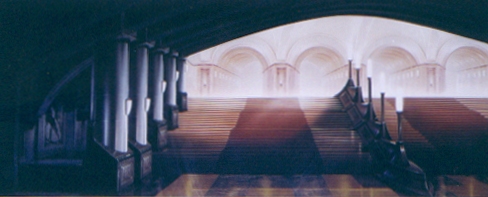
Despite the surrounding conflict, the Temple preserved a semblance of normalcy. The rooftop gardens continued to supply the Order through the refectories and kitchens. Master Yoland Fee oversaw these gardens, situated near the Tower of Reconciliation. Food not grown by Fee was delivered to the Temple by commercial suppliers, unloaded in the lower-level hangars. The Jedi academy annually hosted an Apprentice Tournament, alongside specialized tests for all Order members in a dedicated sparring arena. These tests assessed students' skills and allowed Jedi to scout potential apprenticeship candidates.
Following the Temple's invasion and destruction, the interior was scarred with blaster marks. Ceilings had collapsed in several areas, and pillars lay scattered across the ancient halls. Marble floors were fractured, and bookshelves were overturned. Stormtroopers occupying the Temple sealed off sections with massive blastdoors, accessible only to the Emperor. From the outside, the Temple appeared as a charred remnant, a stark reminder of resistance against the Empire.
The Jedi Temple debuted in 1999 with the release of Star Wars: Episode I The Phantom Menace. It was subsequently included in Star Wars: Episode VI Return of the Jedi in a DVD edition.
Christian Piccollo, the artist responsible for the Temple's cross-section in the book Star Wars: Complete Locations, extensively detailed its interior layout. His depiction established the locations of the Jedi Archives, the main entrance, and the sacred spire at the Temple's core.
In Star Wars Infinities: A New Hope, the Jedi Temple becomes Palpatine's residence after the Empire's formation. This concept was later incorporated into official canon in the 2014 novel Tarkin.